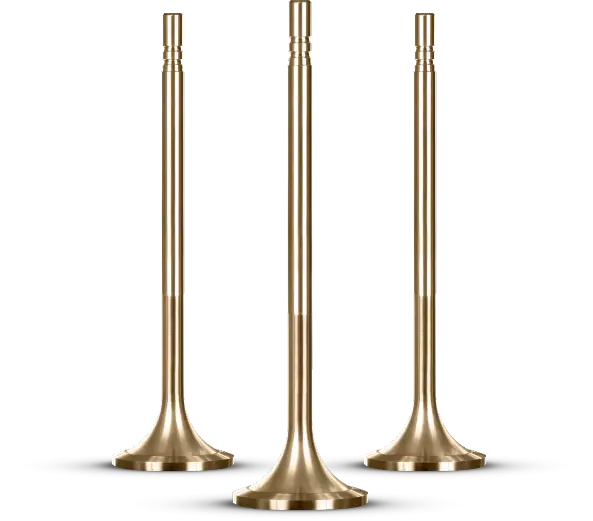Catalogue
Engine Valve
Engine Valve

In internal combustion engines, two different types of valves are used. The valve called the intake valve allows fresh air/fuel mixture to enter the cylinders. It performs this function by opening and closing the intake port. The other valve, called the exhaust valve, allows the burned gases to be expelled from the cylinder. It performs this function by opening and closing the exhaust port.
Special Operations on Valves
A/S: Two-Piece Valves:
To significantly extend the service life of valves, especially exhaust valves, two-piece designs are utilized. The valve head is manufactured from austenitic steel, which offers excellent resistance to heat, corrosion, mechanical stress, and wear. The stem is made from martensitic steel, known for its wear resistance at standard temperatures.
Ni: Nitrided Valves:
Nitriding enhances the strength, corrosion resistance, and wear resistance of valve steel. The nitrided layer is not brittle and does not flake off. In high-alloy steels, nitriding can increase fatigue life by up to 80%. This process reduces friction, improves corrosion resistance, and decreases the likelihood of valve sticking, even without lubricants.
Y: Induction-Hardened Seat Surface Valves:
To prevent wear on the valve seat surface, especially in intake valves, induction hardening is applied.
Cr: CHROME-PLATED VALVES:
Valve stems are coated with chrome to increase surface hardness and minimize wear. This process significantly enhances stem resistance against corrosion and also extends the lifespan of the valve and guide unit by reducing functional forces.
Valve Raw Materials
S (CrSi)
Martensitic valve material alloyed with chromium and silicon. It is resistant to high temperatures, extreme stress, and corrosion. Used in the production of intake valves operating under normal conditions.
O (CrMo)
A valve material alloyed with chromium, molybdenum, and vanadium. It is the most durable among the martensitic group. Used in the production of intake and exhaust valves operating under high stress.
A (CrNiMn)
A valve material alloyed with chromium, nickel, and manganese. Used in exhaust valves operating under high stress. Highly resistant to combustion and corrosion. Unaffected by leaded fuel. Being austenitic, it is non-magnetic.
R (CrMoMn)
A standard austenitic valve material alloyed with chromium, nickel, and manganese. Resistant to heat, combustion, and corrosion. Used in intake valves operating under high stress.
X (CrSi)
Standard austenitic material enhanced with nitrogen for increased strength, hardness, and corrosion resistance at high temperatures. Used in the production of exhaust valves under normal conditions and intake valves under heavy-duty conditions.
| Raw Materials Used In Valve | |||||
| MATERIAL COMPOSITIONS | |||||
| SYMBOL | S | A | O | R | X |
| MATERIAL NO | 1,4718 | 1,4871 | 1,4748 | 1,4785 | 1,4875 |
| DIN | X45CrSi 93 | X53CrMnNIN219 | X85CrMoV182 | x60CrMnMoVNbN 2110 | X55CrMnNIN208 |
| CHEMICAL ANALYSIS | % | % | % | % | % |
| C | 0.40-0.50 | 0.48-0.58 | 0.80-0.90 | 0.57-0.65 | 0.50-0.60 |
| SI | 2.70-3.30 | s0.25 | s1.00 | s0.25 | s0.25 |
| Mn | s0,80 | 7,00-10,00 | s1,50 | 9,50-11,50 | 7,0-10,0 |
| P | s0.040 | s0.050 | s0.040 | s0.050 | s0.050 |
| S | s0,030 | s0,030 | s0,030 | s0,025 | s0,030 |
| Cr | 2.00-10.00 | 20.00-22.00 | 16.50-18.50 | 20.00-22.00 | 19.50-21.50 |
| Mo | --- | 2.00-2.50 | 0.75-1.25 | ||
| Ni | --- | 3.25-4.50 | s1.50 | 2.00-2.75 | |
| V | --- | --- | 0.30-0.60 | 0.75-1.00 | --- |
| W | --- | --- | --- | --- | --- |
| OTHERS (Max) | --- | 0.38-0.50 | 0.20-0.40 | ||
| TENSILE STRENGTH (N/mm2) | 900-1100 | 950-1200 | 1000-1200 | 1000-1250 | 900-1150 |
| LINEAR EXPANSION COEFFICIENT (20°C-700°C)(cm/cm °C)X10' | 13.9 | 18.5 | 12.5 | 18.5 | 18.5 |
